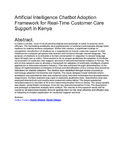| dc.contributor.author | Nyongesa, Geoffrey | |
| dc.contributor.author | Omieno, Kelvin | |
| dc.contributor.author | Otanga, Daniel | |
| dc.date.accessioned | 2021-12-20T05:10:41Z | |
| dc.date.available | 2021-12-20T05:10:41Z | |
| dc.date.issued | 2020-11 | |
| dc.identifier.uri | https://doi.org/10.32628/CSEIT20667 | |
| dc.identifier.uri | https://www.researchgate.net/publication/348462595_Artificial_Intelligence_Chatbot_Adoption_Framework_for_Real-Time_Customer_Care_Support_in_Kenya | |
| dc.identifier.uri | http://ir-library.mmust.ac.ke:8080/xmlui/handle/123456789/1886 | |
| dc.description.abstract | In today’s society, most if not all sectors digitize and automate in order to become more efficient. The increasing availability and sophistication of software technologies disrupt labor markets by making workers redundant. Within this context, a significant change is companies’ introduction of chatbots as a supplement to human customer support is vital. Chatbots are computer programs that interact with humans through natural language. The purpose of chatbots is to simulate a human conversation in response to natural language input through text or voice. There seems to be no proper guidelines for adoption of chatbots for provision of customer care support services in telecommunication industry in Kenya. The aim of this research was to develop a framework for adoption of artificially intelligent chatbot application in telecommunication industry. This was achieved through determination of the status of implementation of chatbots in Kenya and identification of key metrics that served as indicators for chatbot adoption. The metrics were identified through review of previous technology adoption frameworks and models. The study adopted mixed methods where qualitative and quantitative data was collected using interview schedules and questionnaires respectively. Content analysis was used in analyzing qualitative data. Quantitative data was analyzed descriptively and results were presented using tables. The target population included experts in the field of AI in two telecommunication firms in Kenya. The study sample was drawn, using Delphi technique, from the two telecommunication firms. The descriptive and principal component analysis were utilized. The results of this research study will be crucial to all telecommunication firms in guiding them on the most effective and efficient way of adopting AI chatbot application for customer support services | en_US |
| dc.language.iso | en | en_US |
| dc.publisher | International Journal of Scientific Research in Computer Science, Engineering and Information Technolog | en_US |
| dc.subject | Artificial, Intelligence, Chatbot, Adoption, Framework, Real-Time, Customer Care, Support | en_US |
| dc.title | Artificial Intelligence Chatbot Adoption Framework for Real-Time Customer Care Support in Kenya | en_US |
| dc.type | Article | en_US |

